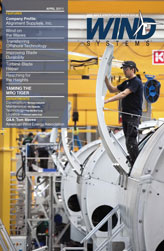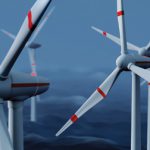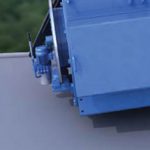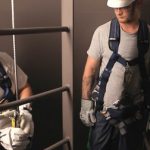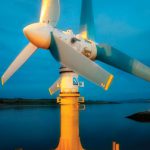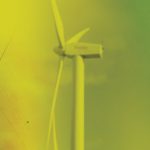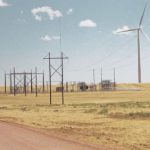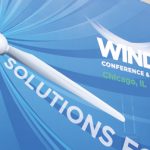Today’s wind turbine blades are large, robust structures, but they are prone to damage like any other composite component. This damage can begin to occur even as blades are being de-molded or moved around the blade factory. The blades then usually travel long distances to their end destination, often negotiating ports, roads, towns, and being manipulated with forklift trucks and cranes. Each of these handling steps creates the opportunity for further damage. Once on site the assembly process and hoisting of the completed rotor up onto the tower is a final opportunity for damage to occur before the rotor has made even one revolution. Once in operation the blades begin to see erosion from rain, dust, and other atmospheric contamination, and lightning strikes add to the amount of damage that a blade experiences. With the constant fatigue loading from rotation and wind gusts, any hidden manufacturing flaws may also start to show up in the form of cracks in the blade surface, inside the laminates, or between the blade components.
Keeping blades in good condition is vital to the ability of the turbine to generate its designed power. Even relatively small amounts of leading edge erosion can affect the aerodynamic profile of the blade, leading to a performance drop of 3-4 percent and consequent loss of revenue. If erosion of leading edges is left unrepaired, then moisture can penetrate. If the temperature then drops below freezing the creation of ice can, in some instances, split the blade edges or de-bond a section of a load-bearing beam.
Whatever the root cause of the damage, most blade repairs are typically carried out using wet epoxy or polyester resin systems, usually based on the resins with which the blades were originally built. However, these wet resin systems typically need to be applied at temperatures above 12-15°C, and to meet GL requirements need to be cured for at least 24 hours or receive an elevated temperature post-cure. This means that not only is there a narrow weather window when repairs can be carried out, but the turbine is also out of action for a considerable period of time. Additionally, these wet resin systems need to be accurately mixed, tend to generate high levels of waste, and can be difficult and messy to use. This is especially the case when operating from the ropes or suspended work platforms often used to access the blades, especially when high winds and cold temperatures are added to the equation. Figure 1
Gurit has been providing its epoxy resin systems for blade repairs for many years, and it was through seeing an increase in the amount of blade repairs and maintenance being carried out, and recognizing the limitations of existing resin products, that an alternative approach was developed.
Blade Repair System
Gurit’s RENUVOTM blade repair system uses UV light from specially-designed lamp equipment to achieve full cure in just a few minutes, and it is designed to be handled at temperatures as low as 5°C and in high humidity conditions. This greatly widens the weather window for carrying out repairs, and dramatically reduces the turbine downtime. The materials are also very easy to handle, requiring no mixing or awkward hand-impregnation of heavy glass fabrics.
The RENUVO product range consists of two main types of material. For small “maintenance” repairs such as leading-edge erosion, small holes, and other surface defects, the MPS product can be used on its own. The MPS is a multi-purpose, single-component resin system supplied in a 310ml cartridge that fits a standard mastic gun. With its grease-like consistency it can be easily applied with small spreading tools and is cured in just 90 seconds with the small, handheld RENUVO Neolectron lamp.
For larger repairs where the blade laminate itself needs to be replaced or reinforced, the prepreg is used. This consists of a biaxial or unidirectional fabric that is already impregnated with a version of the RENUVO resin system. The material, which has a slight “tack” to it, can be easily cut to the desired patch size and can be used in single or multiple layers. Excellent bonding to the existing blade laminate is achieved through the use of the MPS resin acting as an interface. Full cure is obtained in 90-180 seconds, depending on thickness, using the RENUVO LED 400F lamp, with repairs up to 5mm thick being possible in one cure step. For large areas of repair this lamp is “indexed” over the repair area using a specially designed lamp mounting system that ensures each part of the repair patch receives the correct UV dose. An extra “sacrificial” layer of MPS resin can also be applied to the top surface of the repair patch prior to cure, so that when the repair area is then sanded prior to painting no structural reinforcement is abraded away. Both MPS and prepreg are available in a winter and summer grade. This means that each product has the optimum handling characteristics for application in temperatures from +5 to 30°C (41 to 86°F). Figure 2
In addition to a high tolerance to high and low temperature and humidity levels, RENUVO products offer a number of other benefits to those involved in repairing blades. Due to the nature of the UV curing system a full and rapid cure is achievable without the need for heat application or a lengthy wait. The rapid application and cure time enables wind turbines to return to service considerably sooner following a repair than when using wet resin systems, and with the confidence that the full properties of the laminate have been achieved.
For repairs that require more than one layer of reinforcement, Gurit offers the HVC device that allows pre-cut plies to be consolidated into one single repair patch. This heated, vacuum consolidator means that application of a multi-layer patch to a blade can be carried out very quickly and with extremely low void contents. A thin layer of MPS is applied to this patch to ensure adequate wetting and adhesion to the substrate. Alternatively, the prepreg can be applied in single plies to the repair with a thin layer of MPS applied between each layer.
Lamp Technology
During the development of RENUVO, Gurit evaluated a wide variety of UV lamp systems. Mercury vapor or metal halide lamps, which are typically used for UV-cured inks and coatings, are in common use but were felt to be insufficiently robust for an in-field repair system, where exposure to poor weather and rough handling would be inevitable. Gurit therefore worked with two separate lamp manufacturers to develop two high-intensity lamps that are both based on LED (Light Emitting Diode) technology. The lamp systems were then “ruggedized” to an IP54 rated level, meaning that the equipment is fully resistant to the worst kinds of weather. Figure 3
An additional advantage of the LED system is that unlike mercury vapor lamp technology, it can be switched on and off without damage or a drop in light intensity. The RENUVO LED 400F high intensity UV lamp system is used for the structural prepreg repairs, while the smaller Neolectron hand-held lamp, which has a lower power and smaller beam area, can be used for rapid spot repairs using the MPS paste alone. The larger LED 400F unit can also be programmed via a USB interface enabling a single-button operation for in-field use. This means that it can also be re-programmed in the field for a shorter cure if a thinner laminate stack is being cured. Figure 4
Testing and Evaluation
Extensive testing on the system has been carried out in Gurit’s prototyping center, as well as on real blades. Adhesion of the repair materials to the three main types of resin systems used to manufacture blades was tested using a variety of methods, including double lap shear and fracture toughness, at different temperatures and humidity. Samples were also immersed in water to assess the durability of the repair. All RENUVO products are approved by GL for use in blade repair.
Cast History #1: The UV Cure
RENUVO MPS has been chosen by Renewable Advice for use in wind turbine blade repair operations. Renewable Advice is an established blade operations, maintenance, and repair company with many years of experience working in both blade manufacturing and in-field support. Their rapid response to customer demand has led them to reduce their use of traditional wet lamination techniques and introduce the RENUVO blade repair system.
The Challenge: Completing maintenance repairs under poor weather conditions. “Weather conditions in the U.K. are very challenging, meaning we have had to react quickly to ensure we complete repairs when the temperature is +15°C or above,” says Renewable Advice Director Benn Faulkner. “We have been looking for a solution to enable us to offer maintenance and repair services throughout the year.”
The Solution: Renewable Advice chose RENUVO MPS to shorten the repair cycle time, improve the quality of the operation, and to extend the weather window for repair. “For us it means we benefit greatly from the simple application and rapid UV cure, to help set us apart from the competition,” Faulkner says. “We’ll always consider using RENUVO first.”
The MPS resin chosen in this application has the primary advantages of being able to be used at working temperatures down to +5°C, being a single component resin—which eliminates the need for mixing pots or nozzles—and 100-percent cure in 90 seconds. The result is a simple and clear repair that can be repeated efficiently and consistently.
Cast History #2: Structural Repair
RENUVO PP prepreg has been adopted by BS Rotor Technic for turbine blade repairs. BS Rotor Technic is a global provider of inspection and maintenance services to blade OEMs and wind farm operators. Their platform access system provides both easy access and a stable working environment. The clean and error-free repair process of the RENUVO blade repair system has made the switch an easy decision.
The Challenge: Eliminating errors in structural repairs. “Having to stock many different resin systems, depending on what type of blade is being repaired, is a logistical headache,” according to BS Rotor Technic Managing Director Jeremy Sheppard. “Applying wet systems when in-field bears the risk of contamination, error in composition and quality control. Compounding this is the waste generated from mixing pots and unused materials.”
Structural repairs are an everyday activity for the company. The wet laminating systems used are typically two-component resins, requiring offline mixing and long mixing nozzles that create excessive waste. Additionally, in poor weather heater blankets and IR heaters are required to cure the product to the levels required by GL.
The Solution: BS Rotor Technic selected RENUVO PP to streamline the procurement process and improve customer service. “The use of RENUVO PP will increase our in-field efficiency by reducing the number of resins we need to transport,” Sheppard says. “It also allows us to finish the repair perfectly, even when the weather is deteriorating fast. Not to mention we no longer need to tell the wind farm operator that their turbine should remain offline for 24 hours.”
The primary benefit of the system chosen in this application is its simple “repair kit in a box” approach, with the correct grade being selected to match the working temperature.
Conclusions
The RENUVO system has been well received by all the blade builders and blade repair companies who have used it, and the products are now in the final stages of approval with several of the blade OEMs. Rope teams have been particularly impressed by how clean the system is to use, and the opportunity to take RENUVO with them on inspections to repair minor defects. Those working from platforms are excited by the time-saving opportunities RENUVO presents, and all users appreciate the wider weather window it offers.



















